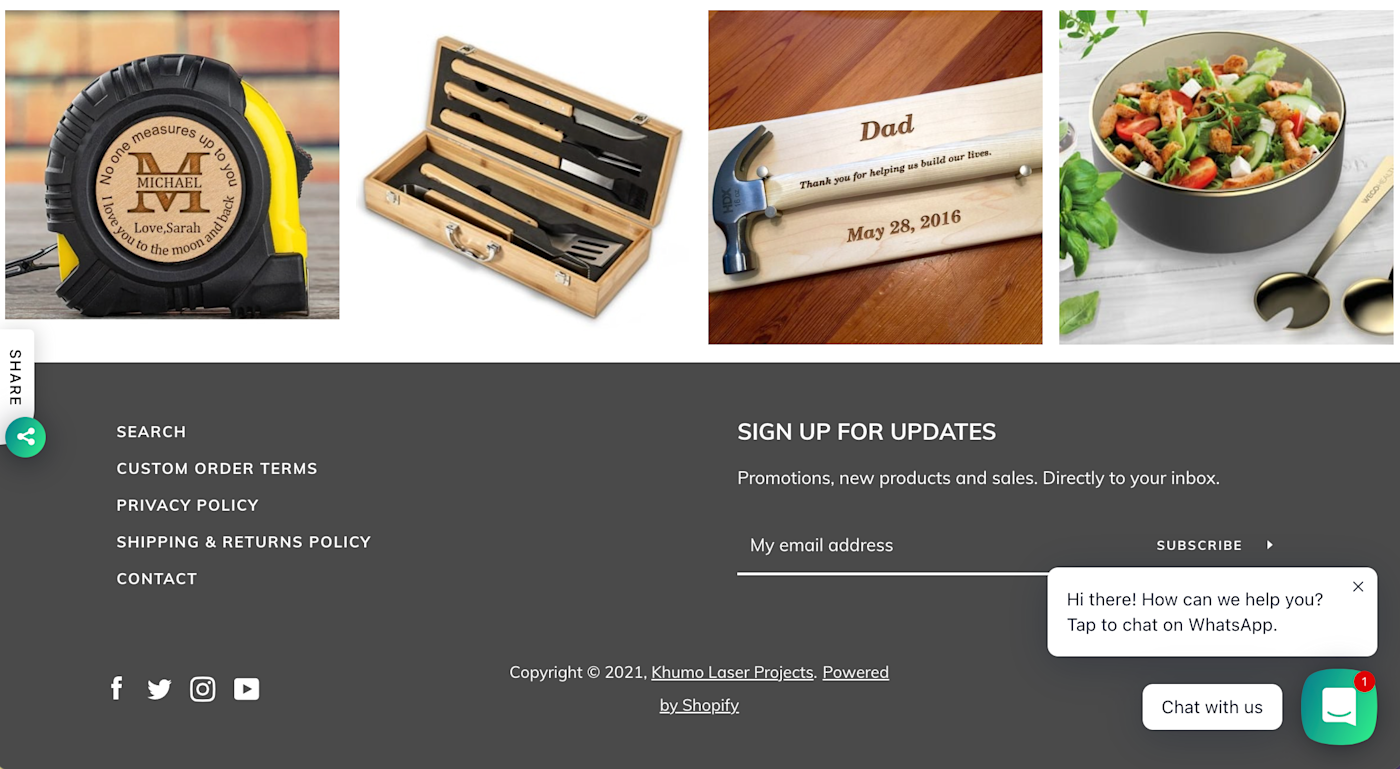After running my small business for five years, I knew my business backward and forward—and so did my customers. But that didn't magically happen on its own: it happened because I created and documented processes and then shared those with my customers, ensuring that we were always on the same page. And that meant a level of trust they didn't have with my competitors.
I witnessed the other side of this when my husband started a laser cutting and engraving business this year. The lack of transparency in his policies and processes made it so that customers expected one thing and got another. I spotted this happening and helped him develop and present clear policies to his customers: custom order terms, return policies, standard production lead times, extra charges for express orders, and more. His customers were happier, he was happier—everyone wins.

The more transparent you are, the more likely you are to meet your customers' expectations. And when someone knows what they're doing to get from you, they're more likely to stick around.
Why transparency matters in business
Transparency is more than just a feel-good buzzword that businesses throw around in PR campaigns. It's about being open and honest and making it easy for customers to understand what you're about as a business—and what to expect when they buy from you.
As a nail bar owner, I was forced into transparency in some ways: all of our customers literally watched us do their manicures. They saw what products we were using and witnessed the meticulous grooming of the fingernails, the smooth application of the gel, and the detailed artwork.
But if what you're selling doesn't allow you to do that, you need to pull back the curtain yourself. For example, you might educate your customers about the materials you source—that can help build trust while also increasing the perceived value of your product or service and making people willing to pay more.
Of course, being clear and transparent with your customers also helps you avoid any uncomfortable situations. If someone doesn't arrive on time for an appointment or wants to return an item that's not returnable, you have something very specific to point to. And if you've been transparent about it, they can't claim that they didn't know the policy.
So shout your policies—even the ones that aren't your customers' favorites—from the rooftops. Here are some tips for how to do just that.
How to achieve transparency in your business
It can be hard to figure out how to be transparent about your business without giving away trade secrets or sensitive business information. But there are a few spots that every business can focus on.
1. Simplify pricing
For buyers, it always comes down to the bottom line. They don't want to know about how much it will cost—they want to know exactly how much it will cost.
If pricing is complicated, people will start to think they're about to be caught off guard with some fine print they missed. They might walk away right then and there, but even worse, they might buy from you, be surprised by the cost, and then tell other people about their experience.
Some B2B companies will omit pricing altogether, so they can be sure they're offering a fully custom quote. But be warned: someone, somewhere on the internet, has published how much your product or service costs. You want to get ahead of that by giving people something: a starting point, a range, or even some examples to show how vastly different pricing can be. As a bonus, it removes a barrier to entry for prospects.
2. Clarify your policies and deliverables
Ok, this one is kind of vague, but it's important: make sure all your customer-facing policies and deliverables are obvious to those customers. Here are some examples, but keep in mind that it's not exhaustive:
If you're a service-based business, have a clear scope of service for each of your offerings, so clients know exactly what to expect. (This needs to be in writing.)
If relevant, create detailed quotes, with granular line items, especially if you're doing custom pricing. Think about the quotes you get from a mechanic—that's what you're going for.
If you're an eCommerce retail business, your product descriptions should be robust and super detailed. (You might even consider making a video for each product.)
If you sell a physical product, do you offer returns? If so, who pays for the postage? What do customers ship the item back in? Do they pay for that packaging? How long do they have to return it? What condition does it need to be in? All those things need to be clear.
3. Let customers into your kitchen
When there's high perceived risk, customers will try to reduce their fear by gathering more information, looking for anything that quells their doubts.
Instead of letting them find that one negative review, give them that information yourself. Think of it like a fine dining experience, where you get to watch the chef cook your food. Not only is it downright delightful for the customers, but they'll also be more patient with the pace and more excited to eat the food once it gets to them.
TikTok is an amazing place to let your customers peek behind the curtain. I personally love watching business owners making their hand-poured soy candles—so satisfying. Some businesses will share videos of them packaging orders and shipping them to customers. Of course, other platforms work too: my husband's business posts Instagram videos of the laser machine hard at work with engraving, and they all live on his story highlights as B.T.S. or "behind the scenes" videos.

4. Communicate often
The good and the bad—always communicate. It's as simple as sending notifications when shipping is delayed, emailing your list when there are changes to pricing, shouting out updated policies on social media...the list goes on.
But it's not just one-way communication: you want your customers to be able to reach you too. When my husband started his business, we knew that our target audience wasn't as trusting of online shopping for this kind of work. So we immediately added a WhatsApp chat widget to our site, so they could always chat with a real person on a platform they were comfortable with if they had any questions. If you do any SMS marketing, make sure it's two-way, so your customers feel like the line of communication is always open.
5. Focus on your strengths
Often businesses think of being transparent as letting customers see all their flaws. But look at it this way: transparency also means you get to show off everything you do well, too.
In your entire operations process, what are you most proud of? Why is your way better? What's the result of your better process, and how does it benefit your customers? Don't forget to flaunt all that stuff, even if it means they might (might!) see something less-than-perfect along the way.
6. Tell your story
Transparency goes beyond showing your customers how you function—it's also about who you are. Telling your personal story or just creating a narrative around your brand makes you more relatable and builds trust.
One of my favorite brands, cuddle+kind, does this really well. They sell heirloom dolls, and money from their sales helps feed hungry children. It's a powerful selling point on its own, and they have an "About Us" section on their website that gives customers an even deeper understanding of who they are and what they stand for.

People want to do business with brands whose values align with theirs, so telling them more about who you are and what you believe can help you be sure you're reaching the right audience who'll come back to you time and time again. Simple things like having an "About Us" page or sharing personal stories on social can help bring your transparency into the ethos of your brand as a whole.
7. Follow through
No matter how transparent you are, potential customers will still do their own research to make sure that you live up to your claims—and, of course, if they decide to do business with you, they'll figure it out quickly for themselves.
If you say you do something, do that thing. If you say you don't do something, don't do that thing. It's that simple. It will be reflected in your customer reviews and increased customer retention.
Your customers want to make informed and empowered decisions when buying. Transparency helps them to overcome any friction in the buying process because it helps them determine if your brand is helping them shift their spending habits for the better. Building an open, honest, and accountable brand can be a strong differentiator.
Don't worry too much about your competitors being all up in your business. The less businesses have to hide, the better: it can elevate the entire industry and set the tone for more accountable businesses everywhere.





